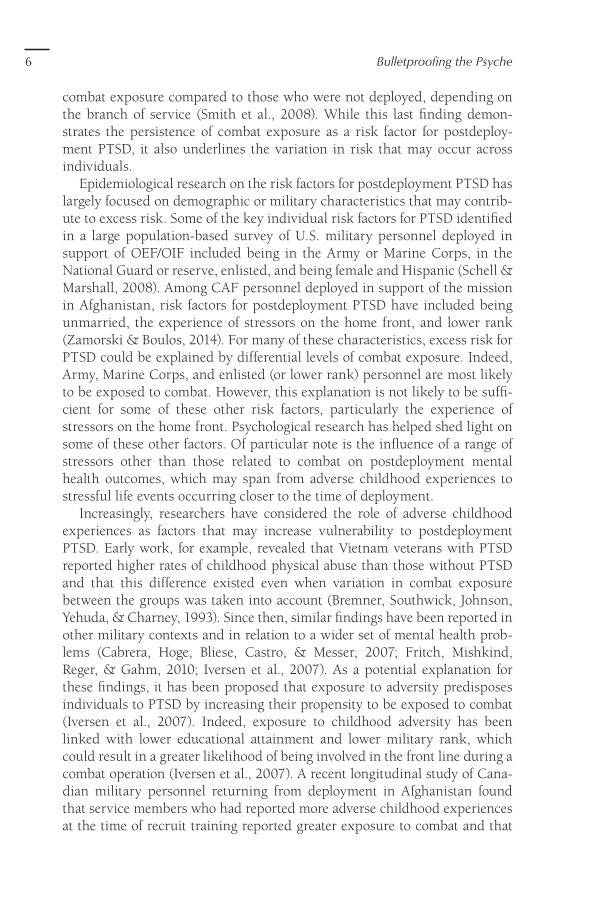6 Bulletproofing the Psyche combat exposure compared to those who were not deployed, depending on the branch of service (Smith et al., 2008). While this last finding demon- strates the persistence of combat exposure as a risk factor for postdeploy- ment PTSD, it also underlines the variation in risk that may occur across individuals. Epidemiological research on the risk factors for postdeployment PTSD has largely focused on demographic or military characteristics that may contrib- ute to excess risk. Some of the key individual risk factors for PTSD identified in a large population-based survey of U.S. military personnel deployed in support of OEF/OIF included being in the Army or Marine Corps, in the National Guard or reserve, enlisted, and being female and Hispanic (Schell & Marshall, 2008). Among CAF personnel deployed in support of the mission in Afghanistan, risk factors for postdeployment PTSD have included being unmarried, the experience of stressors on the home front, and lower rank (Zamorski & Boulos, 2014). For many of these characteristics, excess risk for PTSD could be explained by differential levels of combat exposure. Indeed, Army, Marine Corps, and enlisted (or lower rank) personnel are most likely to be exposed to combat. However, this explanation is not likely to be suffi- cient for some of these other risk factors, particularly the experience of stressors on the home front. Psychological research has helped shed light on some of these other factors. Of particular note is the influence of a range of stressors other than those related to combat on postdeployment mental health outcomes, which may span from adverse childhood experiences to stressful life events occurring closer to the time of deployment. Increasingly, researchers have considered the role of adverse childhood experiences as factors that may increase vulnerability to postdeployment PTSD. Early work, for example, revealed that Vietnam veterans with PTSD reported higher rates of childhood physical abuse than those without PTSD and that this difference existed even when variation in combat exposure between the groups was taken into account (Bremner, Southwick, Johnson, Yehuda, & Charney, 1993). Since then, similar findings have been reported in other military contexts and in relation to a wider set of mental health prob- lems (Cabrera, Hoge, Bliese, Castro, & Messer, 2007 Fritch, Mishkind, Reger, & Gahm, 2010 Iversen et al., 2007). As a potential explanation for these findings, it has been proposed that exposure to adversity predisposes individuals to PTSD by increasing their propensity to be exposed to combat (Iversen et al., 2007). Indeed, exposure to childhood adversity has been linked with lower educational attainment and lower military rank, which could result in a greater likelihood of being involved in the front line during a combat operation (Iversen et al., 2007). A recent longitudinal study of Cana- dian military personnel returning from deployment in Afghanistan found that service members who had reported more adverse childhood experiences at the time of recruit training reported greater exposure to combat and that
Document Details My Account Print multiple pages
Print
You have printed 0 times in the last 24 hours.
Your print count will reset on at .
You may print 0 more time(s) before then.
You may print a maximum of 0 pages at a time.































































































































































































































































































